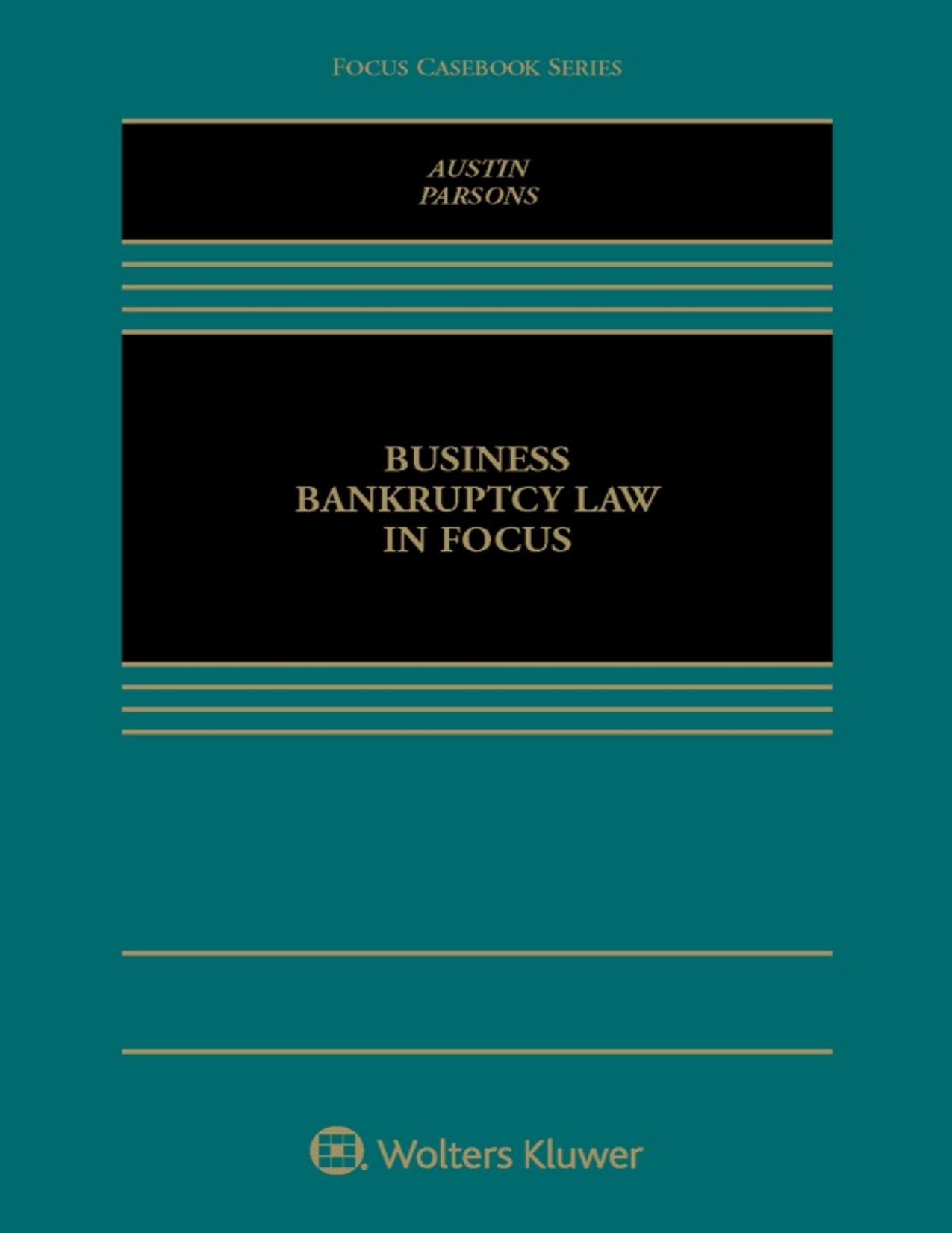Business Bankruptcy Law in Focus Focus Casebook 1st edition by Daniel Austin , Stephen Parsons 1454868066 9781454868064
$70.00 Original price was: $70.00.$50.00Current price is: $50.00.
Instant download Business Bankruptcy Law in Focus Daniel A. Austin;Stephen P. Parsons; after payment
Business Bankruptcy Law in Focus Focus Casebook 1st edition by Daniel Austin , Stephen Parsons – Ebook PDF Instant Download/Delivery:1454868066 , 9781454868064
Product details:
ISBN 10: 1454868066
ISBN 13: 978-1454868064
Author: Daniel A. Austin , Stephen P. Parsons
When you purchase a new version of this casebook from the LIFT Program, you receive 1-year FREE digital access to the corresponding Examples & Explanations in your course area. Now available in an interactive study center, Examples & Explanations offer hypothetical questions complemented by detailed explanations that allow you to test your knowledge of the topics covered in class.
Starting July 1, 2017, if your new casebook purchase does not come with an access code on the inside cover of the book, please contact Wolters Kluwer customer service. The email address and phone number for customer service are on the copyright page, found within the first few pages, of your casebook.
As part of the In Focus Casebook Series, Business Bankruptcy Law In Focus, offers a comprehensive, practice-oriented approach to the legal and practical aspects of business bankruptcy. By providing real world scenarios throughout, the text gives students numerous opportunities to apply what they are learning, and solidify their understanding of important concepts. Clear explanatory text, case previews and case follow ups further clarify the doctrine and aid in student understanding of concepts. With its focus on business bankruptcy, this text begins by reviewing the basics of business entities and debt along with essential business bankruptcy concepts, then moves onto covering powers of debtor in possession, drafting and confirming a plan of reorganization, evolving forms of business bankruptcy (e.g. liquidation of assets, prepackaged and pre-negotiated, structured dismissals, etc.). It then introduces cross-border insolvencies under Chapter 15 of the Code, bankruptcy jurisdiction, including core and noncore proceedings following the Supreme Court decision in Stern v. Marshall.
Features:
- Fresh approach that uses selected cases to illustrate key developments in the law and to show how courts develop and apply doctrine
- Approachable manner and assessment features provide an experiential environment for students
- Hands-on approach encourages students to apply concepts to real-world scenarios, offer many opportunities for students to apply their knowledge
- Assessment features include:
- Real Life Applications
- Applying the Concepts
- Case Previews and Post Case Follow Ups
Table of contents:
Chapter One: Bankruptcy Law: Historical Antecedents and Modern Framework
A. Historical Antecedents
B. Modern Framework
1. Sources of Bankruptcy Law
2. Bankruptcy Courts
3. Trustees
4. Professionals Authorized to Be Employed in the Case
5. The Chapter 11 Process
6. Alternatives to Bankruptcy
Chapter Summary
Applying the Concepts
Chapter Two: Business Entities and Business Debt
A. Basic Forms of Business Entities
1. Sole Proprietorship
2. General Partnership
3. Limited Partnership
4. Corporations
5. Special Purpose Vehicles
B. Basic Forms of Business Debt
1. Secured Debt
2. Unsecured Debt
3. Co-Signers, Guarantors, and Sureties
4. Common Forms of Business Debt
Chapter Summary
Applying the Concepts
Chapter Three: Filing Bankruptcy
A. Debtor’s Duties
1. The Role of Debtor’s Management
2. Petition and Schedules
B. Affiliated Debtors
1. Venue Selection
2. Joint Administration and Substantive Consolidation
Chapter Summary
Applying the Concepts
Chapter Four: The Bankruptcy Estate
A. Scope of Property of the Estate
B. The Butner Doctrine and Non-Bankruptcy Law
C. Turnover
Chapter Summary
Applying the Concepts
Chapter Five: The Automatic Stay
A. Scope of the Stay
1. Exceptions to the Automatic Stay
2. Termination of the Stay
B. Violation of the Stay
C. Relief from Stay
1. Section 362(d): Grounds for Relief from Stay
2. Temporary Stay of Order Granting Relief from Stay
3. Prepetition Waiver of Stay
D. Third-Party Stays
Chapter Summary
Applying the Concepts
Chapter Six: Creditors and Claims
A. Claims Process
1. Proofs of Claim
2. Claims Allowance, Objections, and Estimation
3. Claims Processing in Large Cases
4. Claims Trading
B. Secured Claims
1. The Status of a Secured Creditor in Bankruptcy
2. Adequate Protection
3. Cash Collateral
C. Unsecured Claims
D. Administrative Claims
E. Subordination of Claims and Interests
Chapter Summary
Applying the Concepts
Chapter Seven: The Chapter 11 DIP and First Day Motions
A. Chapter 7 and Chapter 11 Compared
B. Filing Chapter 11
1. Eligibility to File Chapter 11
2. Overview of a Chapter 11 Case
3. The Petition, Schedules, and Other Documents
C. The Debtor as the Debtor in Possession
1. Small Business Debtor
2. Single-Asset Real Estate Debtor
3. Appointing a Bankruptcy Trustee
D. First Day Motions
1. Motion for Order Authorizing Use of Cash Collateral
2. Motion for Authorization to Pay Prepetition Claims of Critical Vendors
3. Other Operational First Day Motions
4. Administrative First Day Motions
Chapter Summary
Applying the Concepts
Chapter Eight: Avoiding Prepetition Transfers
A. Preferential Transfers
1. Preference Claims
2. Preference Defenses
B. Fraudulent Transfers
1. Avoiding Fraudulent Transfer Under §548
2. Avoiding Fraudulent Transfer Under §544(b)
C. The Trustee’s Strong Arm Avoidance Powers
1. Section 544(a)(1) — Hypothetical Judgment Lien Creditor
2. Section 544(a)(3) — Hypothetical Bona Fide Purchaser of Real Property
3. Knowledge of the Trustee
D. Setoff
1. Improvement in Position Test
2. Setoff vs. Recoupment
Chapter Summary
Applying the Concepts
Chapter Nine: Executory Contracts and Unexpired Leases
A. Section 365
1. The Meaning of “Executory Contracts”
2. Assumption and Rejection
3. Assignment of Contract Rights
4. Special Issues Under §365
B. Key Employee Retention and Incentive Programs
1. Overview of KERPs and KEIPs
2. KERPS
3. KEIPs
Chapter Summary
Applying the Concepts
Chapter Ten: Operating the DIP: Section 363 Sales and Debtor in Possession Financing
A. Sales Other Than in the Ordinary Course
1. Section 363 Sale Process
2. The Role of Adequate Protection in Connection with a §363 Sale Motion
3. The Role of the Automatic Stay in Connection with a §363 Sale Motion
4. Credit Bidding
5. Sales Free and Clear
6. The Effect of Reversal or Modification of a §363 Sale
B. Debtor in Possession Financing
1. Postpetition Unsecured Debt Incurred in the Ordinary Course of Business
2. Postpetition Unsecured Debt Incurred in Other Than the Ordinary Course of Business
3. Postpetition Secured Debt
Chapter Summary
Applying the Concepts
Chapter Eleven: The Chapter 11 Plan: Plan Proposal and Contents
A. Plan Proposal — Exclusivity and Time Limitations
B. Classification of Claims and Interests
C. Plan Contents — Sample Plan Overview
D. Impaired Classes and Their Treatment
E. Gerrymandering Claims
Boston Post Road LP v. FDIC (In re Boston Post Road LP)
F. Modification of Secured Claims
G. Amending the Plan
Chapter Summary
Applying the Concepts
Chapter Twelve: The Chapter 11 Plan: Plan Confirmation
A. Disclosure Statement
B. Plan Solicitation and Voting
C. The Chapter 11 Plan
1. Section 1129(a) Consensual Confirmation
2. Section 1129(b) Cramdown
3. Order Confirming Plan
Chapter Summary
Applying the Concepts
Chapter Thirteen: Evolving Forms of Chapter 11
A. Section 363(b) Liquidation of Substantially All Assets
1. Special Considerations for High Dollar Value §363(b) Sales
2. Noncash Components of a Bid
3. Sub Rosa Bankruptcy
B. Pre-Packs and Pre-Negotiated Bankruptcies
C. Structured Dismissals
D. Auto Industry Bankruptcies: Chrysler and General Motors
E. Mass Tort Bankruptcies
Chapter Summary
Applying the Concepts
Chapter Fourteen: Cross-Border Insolvency Under the Bankruptcy Code
A. UNCITRAL Model Law on Cross-Border Insolvency
B. Bankruptcy Code Chapter 15
1. Chapter 15 Purpose and Overview
2. Commencing a Chapter 15 Bankruptcy Case
3. Eligibility and Venue
4. Main and Nonmain Proceedings, and the Importance of COMI
5. Comity and Limitations on the Powers of Foreign Representatives
Chapter Summary
Applying the Concepts
Chapter Fifteen: Bankruptcy Jurisdiction
A. Core and Non-Core Proceedings
1. Core Proceedings — 11 U.S.C. §157(b)
2. Non-Core Proceedings
B. Additional Limitations on Jurisdiction —Abstention and Withdrawal of the Reference
1. Abstention
2. Permissive Abstention (Also Referred to as “Discretionary Abstention”)
3. Mandatory Abstention
4. Withdrawal of the Reference
C. Special Problems of Bankruptcy Jurisdiction
1. Right to Jury Trial in a Core Proceeding
2. Core Matter Jurisdiction Revisited: Stern v. Marshall
3. Stern Claims
D. Procedural Responses to Stern v. Marshall and Its Progeny
Chapter Summary
People also search:
business case book pdf
financial management four business case analysis
7 powers the foundations of business strategy summary
7 powers foundations of business strategy



